


Index:
Orbit
Fuel
Aircraft launch
Future rockets
Power in space
Ion drives
Fission rocket
Fusion rocket
Thermal rocket
Electromagnetic sled
Maneuvers
Chemical rocket engines
Orbital launch systems
Aircraft
 |
 |
 |
|---|---|---|
A rocket generates thrust by burning fuel and channeling the exhaust with a rocket cone.
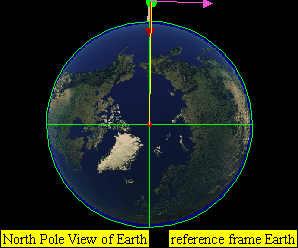 |
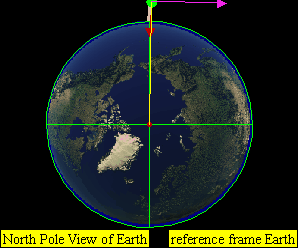 |
|---|---|
To reach orbit you need a velocity of 7.8 km/s. A one-stage rocket isn't enough and so multiple stages are used.
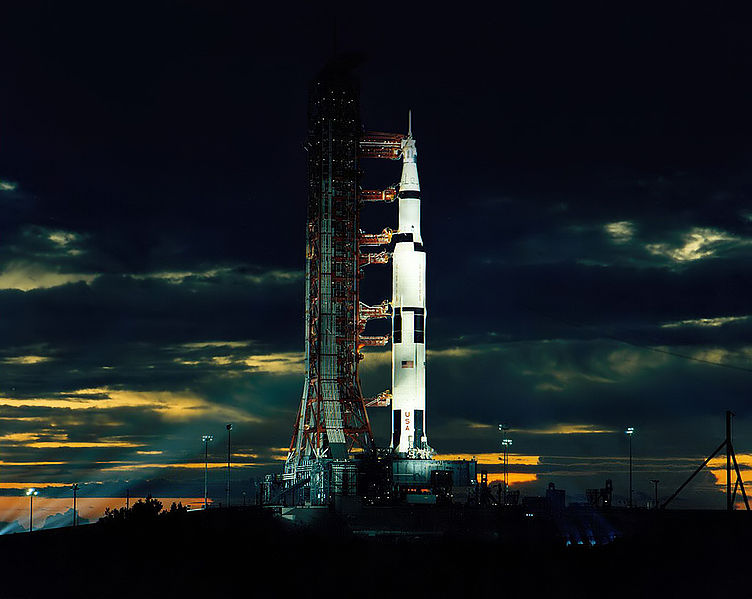 |
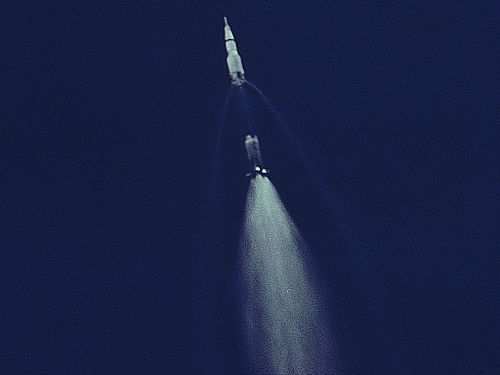 |
.jpg) |
|---|---|---|
The faster the exhaust the faster the rocket.
The fuel that generates the fastest exhaust is hydrogen+oxygen and this is usually used on the upper stages.
The first stage usually uses kerosene+oxygen because liquid hydrogen isn't dense enough.
SpaceX has recently developed the first methane+oxygen rocket, which is a substantial improvement over kerosene+oxygen.
Fuel Exhaust Fuel Fuel boiling
speed density point
(km/s) (g/cm^3) (K)
Hydrogen 4.4 .07 20.3 Complex because of the low boiling point of hydrogen
Methane 3.7 .42 111.7 New technology
Kerosene 3.3 .80 410 Simple because kerosene is a liquid at room temperature
Solid fuel 2.7 1.2 - Simple and cheap
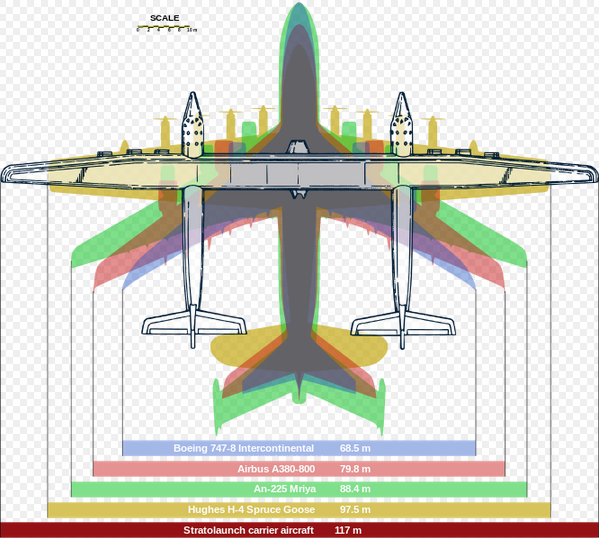 |
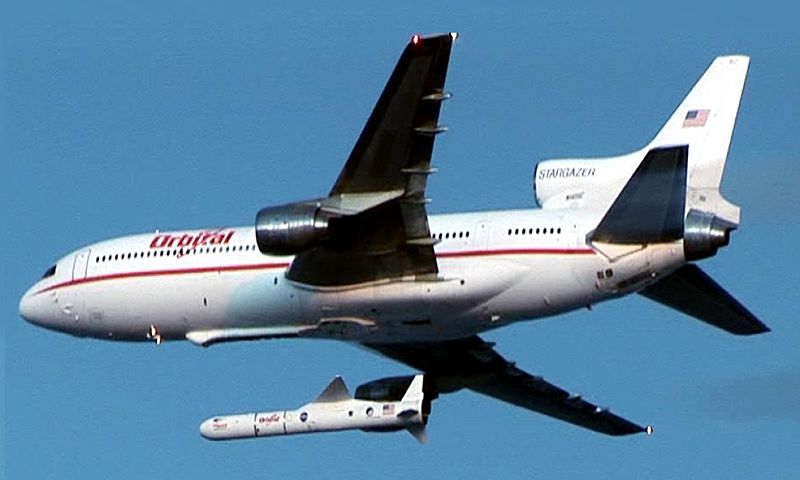 |
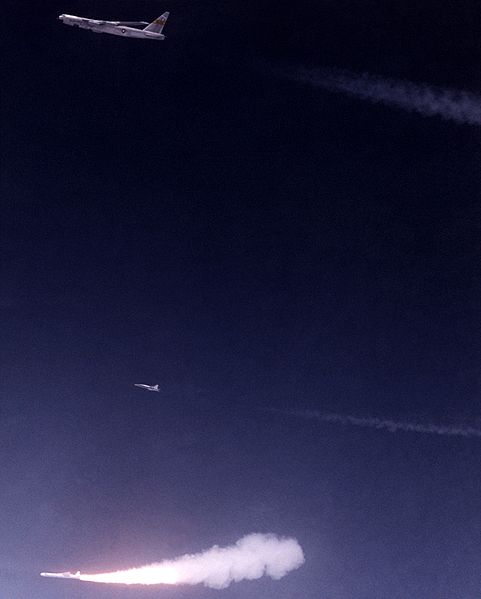 |
|---|---|---|
Vulcan Aerospace is developing the Stratolaunch aircraft to launch rockets from high altitude, yielding several advantages over ground launch.
Speed (km/s)
Earth rotation at equator .46
Stratolaunch aircraft .27
Earth orbit speed 7.8
The rocket will be launched from near the equator so that it benefits from both
the speed of the equator and from the speed of the aircraft.
 |
|---|
The Stratolaunch will fly at 14 km where the air has 1/4 the density as at sea level, giving it an edge over ground launch. A rocket launched from the ground has to respect the atmosphere by first going up before it can go sideways. A rocket launched from an aircraft can go sideways immediately, for a big savings in fuel.
The stratolaunch aircraft has 6 engines for a total thrust of 150 tons and it can carry a 230 ton rocket.
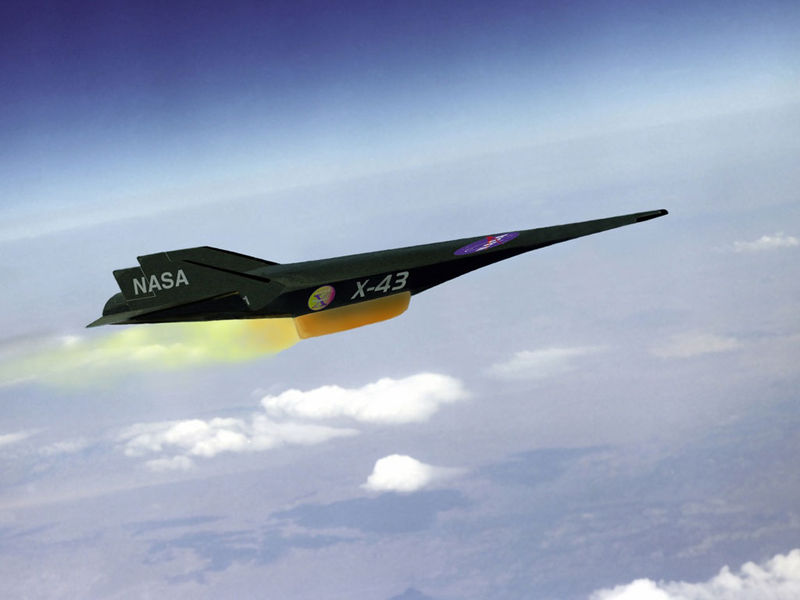 |
|
|---|---|
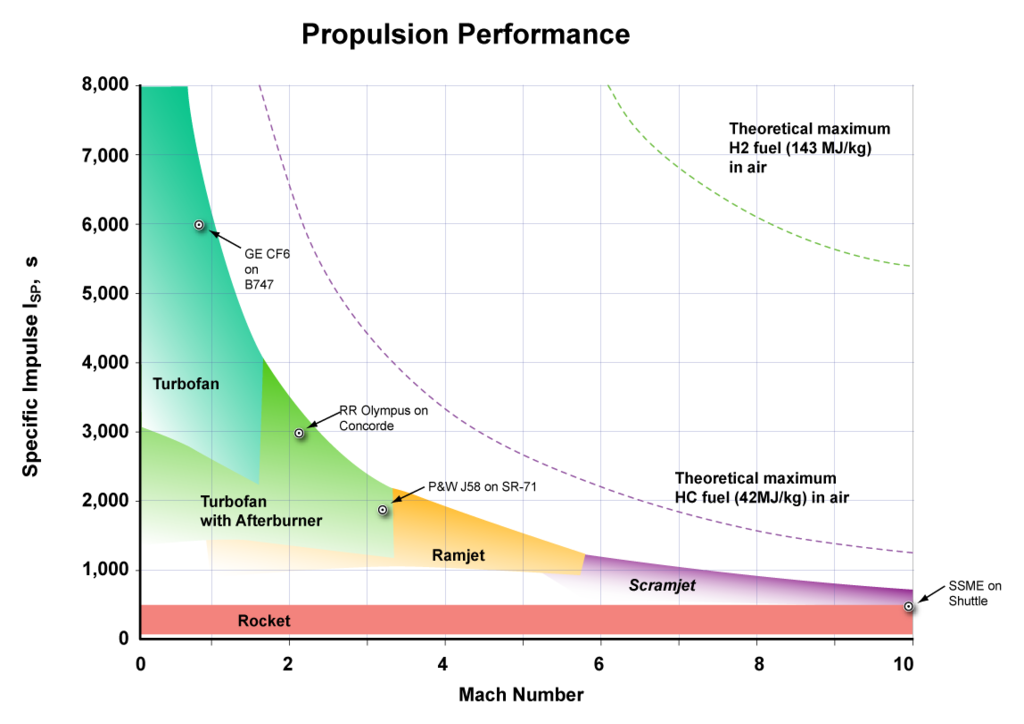 |
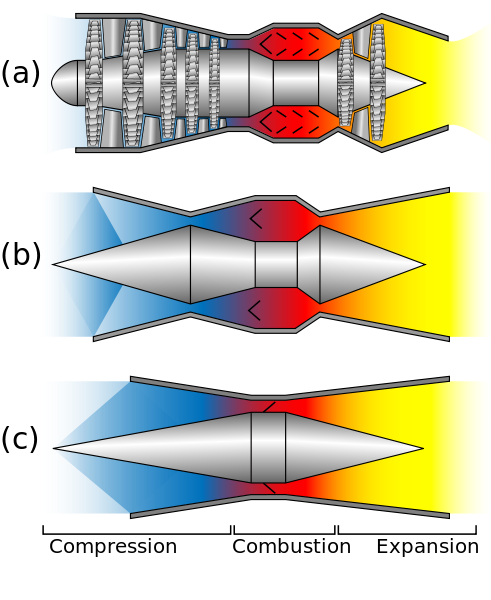 |
|---|---|
In the future, a ramjet aircraft will be built to launch rockets from a speed of Mach 5 and an altitude of 100 km. Since ramjets only work above Mach 1, a detachable solid rocket booster will have to be used to get the aircraft to Mach 1. The aircraft fuselage will be a shell that will contain the rocket, which will be deployed from the aft of the aircraft.
Ramjets work up to Mach 5 and scramjets are required above this speed. Ramjets are a mature technology and scramjets are an emerging technology.
km/s Mach
Earth rotation at equator .46 1.6
Stratolaunch aircraft .27 .9
Ramjet aircraft 1.50 5.0
Earth orbit speed 7.8 20.4
Exhaust speed of HOX fuel 4.4 14.9
Effective exhaust speed of a ramjet 12 40.7 (from specific impulse)
 |
 |
 |
 |
|---|---|---|---|
Reentry spacecraft:
Space shuttle empty mass = 78.0 tons, 7 crew. Launch rocket = 2030 tons SpaceX Dragon V2 = 4.2 tons, 7 crew Soyuz reentry module = 2.9 tons, 3 crew ISRO Reentry Vehicle = 3.7 tons, 3 crewThe space shuttle was senseless because there's no point in bringing unnecessary mass back to the Earth. A reentry spacecraft can be as lightweight as 1 ton/person.
If the rocket fails during launch and the crew are in a lightweight reentry spacecraft, they have the potential to survive.
 |
|---|
 |
 |
.jpg) |
|---|---|---|
 |
 |
 |
|---|---|---|
 |
 |
 |
|
|---|---|---|---|
 |
 |
 |
|
|---|---|---|---|
The moon has ice which can be turned into hydrogen+oxygen rocket fuel using solar power. Ice can be brought into space more cheaply from the moon than from the Earth.
Ceres is the largest asteroid in the asteroid belt and it has abundant ice.
Orbit speed Atmosphere Distance from
(km/s) density (kg/m3) sun (AU)
Earth 7.8 1.22 1.00
Mars 3.6 .020 1.52
Moon 1.68 0 1.00
Ceres .36 0 2.77
A one-stage rocket can easily escape the moon or Mars. Two stages are required for the
Earth.
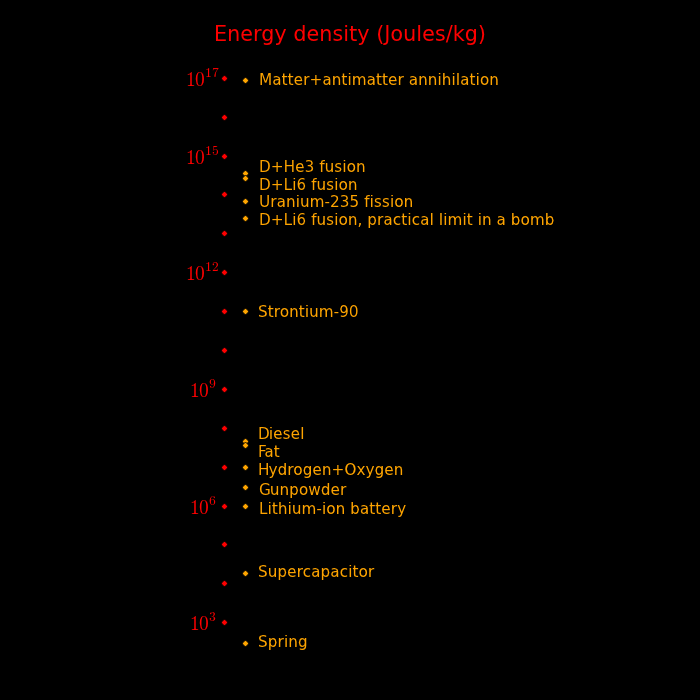 |
|---|
Rocket type Exhaust speed Exhaust speed
(km/s) / speed of light
Antimatter 150000 .5 React matter with antimatter
Fission fragment 12000 .039 Nuclear fission fragments as exhaust
Fusion 4900 .0163 Nuclear fusion of Deuterium + Lithium6
Ion drive 200 .00067 Uses electric power to accelerate ions
Hydrogen + oxygen 4.4 .000015
Methane + oxygen 3.7 .000012
Kerosene + oxygen 3.3 .000011
Chemical rockets and ion drives are proven technologies.
All the other rockets could be built with present technology except for
the antimatter rocket. In the distant future, antimatter rockets will be possible.
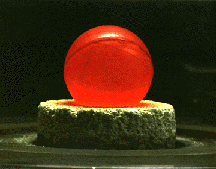 |
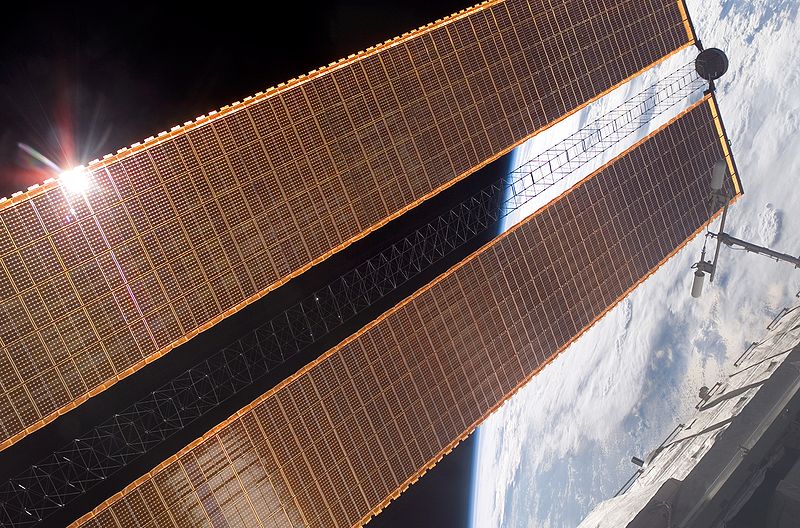 |
|---|---|
Power in space can be obtained from solar cells or from a nuclear battery. Solar cells work best at Earth orbit but they're not useful beyond Mars. Nuclear batteries work everywhere.
In a nuclear battery, radioactivity produces heat and a thermoelectric generator converts the heat to electricity.
The Voyager missions are powered by Plutonium-238 nuclear batteries, which is why they are still functioning 30 years after their launch. Current plutonium-powered missions include Cassini, Galileo, New Horizons, and Ulysses.
Plutonium-238 and Strontium-90 are the isotopes used for nuclear batteries in space, and Curium-244 can be used as well. The possible power sources are:
Power source Generator Watts Halflife Cost
/kg (years) (M$/kg)
Solar cell Optic 300 - .003 Power generated at Earth orbit
Curium-244 Thermo + Optic 40 18.1 .17
Curium-244 Thermo 20 18.1 .17
Strontium-90 Thermo 4 28.8 .01 Product of nuclear reactors
Plutonium-238 Thermo 5.4 87.7 .3 Scarce isotope
Plutonium-238 Stirling 4.1 87.7 .3 Scarce isotope
Nuclear reactor Stirling 200 - ? Data for the SAFE-400 reactor
The numbers for Watts/kg are for the total system, including
the isotope, the shielding, and the generator.
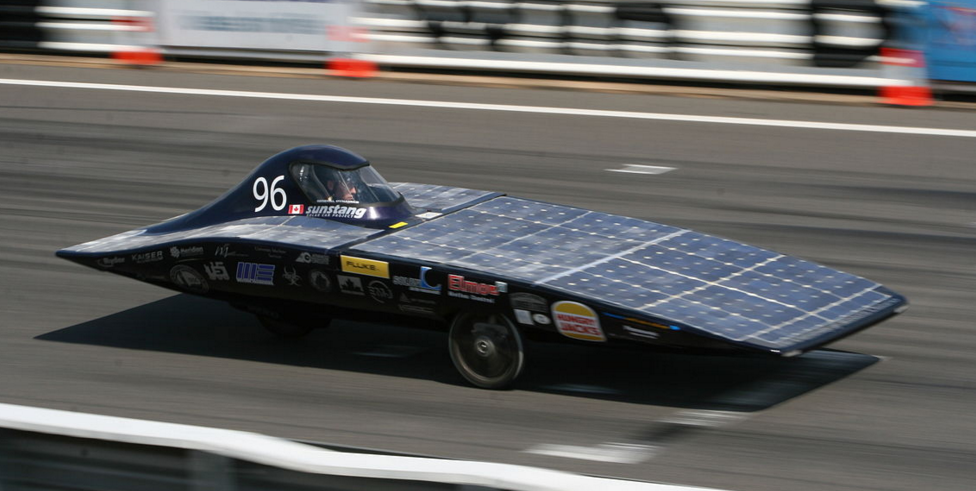 |
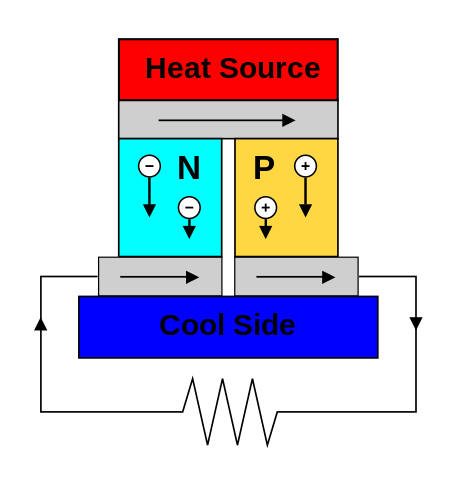 |
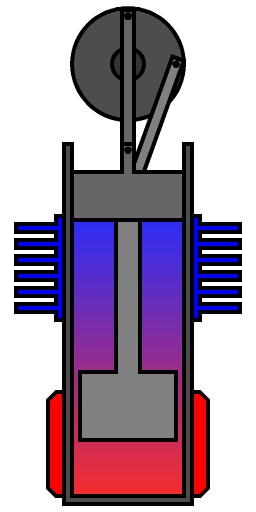 |
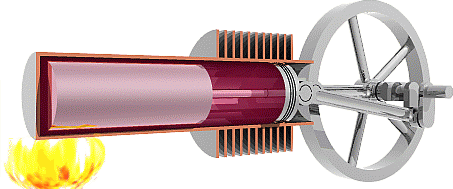 |
|---|---|---|---|
The following methods can convert thermal power to electric power.
Isotope Generator Electrical Fuel Total Temperature
efficiency fraction efficiency (Kelvin)
Plutonium-238 Thermo .07 .14 .0098 1050
Plutonium-238 Photo .07 .14 .0098 1050
Plutonium-238 Stirling .26 .038 .0099 1050
Strontium-90 Thermo .06 .1 .006 800
Strontium-90 Photo .06 .1 .006 800
Electrical efficiency: Efficiency for converting heat to electricity
Fuel fraction: Fuel mass / System mass
Total efficiency: Electrical efficiency * Fuel fraction
The higher the temperature, the more efficient a thermoelectric or optoelectric
generator is.
A thermoelectric generator and an optoelectric generator can work in tandem to produce a greater efficiency than either alone.
Watts GJoules Halflife Decay Decay Cost Produce Stockpile
/kg /kg (years) (MeV) mode (M$/kg) (kg/yr) (kg)
Cobalt-60 27300 4533 5.27 2.82 Beta,γ 1.3
Curium-244 4013 2293 18.1 5.80 Alpha .17
Tritium 1540 598 12.3 .0186 Beta 30 .4
Caesium-137 864 824 30.2 1.17 Beta .01 Huge Huge
Plutonium-238 818 2265 87.7 5.59 Alpha 10 1 17
Strontium-90 648 589 28.8 .55 Beta .01 Huge Huge
The numbers for Watts/kg and GJoules/kg are for the pure isotope and don't
include the surrounding system. The energy density of gasoline is .046 GJoules/kg.
Strontium-90 and Caesium-137 are generated en masse as fission products in fission reactors.
For an isotope:
Atomic mass unit = Mamu = 1.661⋅10-27 kg # of nucleons in nucleus = N Mass of nucleus = Mnuc N Mamu 1 MeV = 1.602⋅10-13 Joules (1 Mega electron Volt) Nucleus decay energy = Edecay Nucleus energy/mass = S = Edecay / Mnuc Decay half life = T Heat power per kg = Qheat = Edecay / T / Mnuc Electric power per kg = Qelec Efficiency = ε = Qelec / Qheat (for converting heat to electric energy) Fuel mass = Mfuel System mass = Msystem Fuel fraction = ffuel = Mfuel / Msystem System power per kg = Qsys = ε ffuel Qheat
.svg.png) |
|
|---|---|
A pebble bed nuclear reactor doesn't melt down if the cooling system fails because it's engineered to turn off if it overheats. It's also designed so that adding and removing fuel pebbles is easy. The reactor is easy to build and it can be operated in space.
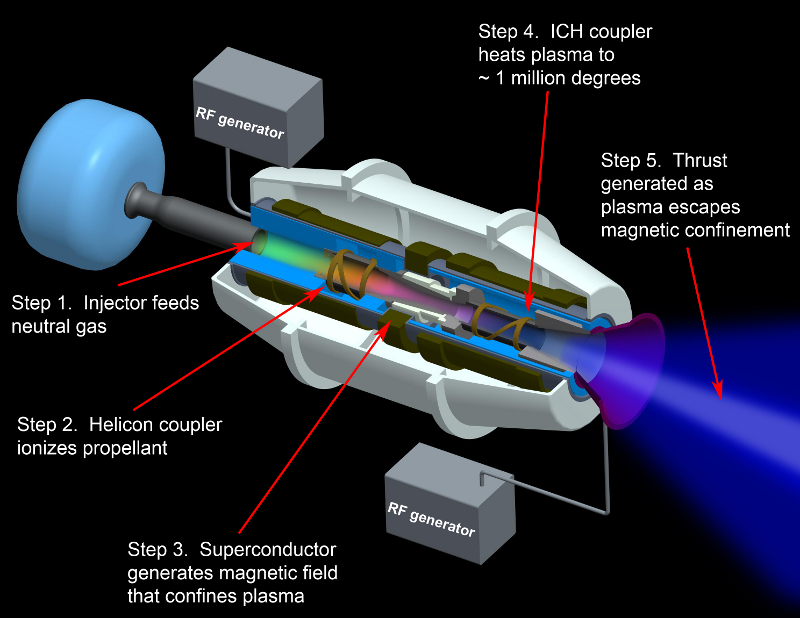 |
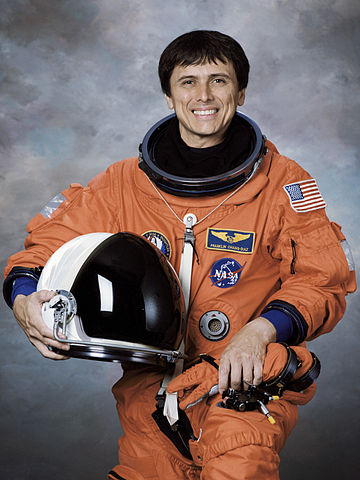 |
|---|---|
An ion drive uses electric power from a nuclear battery to accelerate ions. The values given in the table are for the Chang Diaz ion drive.
V = Ion speed = 50 km/s M = Mass of ion drive = 1000 kg m = Mass of ions ejected per second = .000096 kg/s Po = Power consumed by the ion drive = 200000 Watts Q = Efficiency of the drive = .6 For converting electric to ion power P = Power delivered to the ion beam = 120000 Watts = Q Po = .5 m V^2 F = Force generated by the ion beam = 4.8 Newtons = m V A = Acceleration of spacecraft = .0048 m/s2 = F / M = 2 P / (M V) Agi= Agility = Power/Mass = 120 Watts/kg = P / MAt fixed ion speed, the acceleration is determined by the power-to-mass ratio of the power source.
A = (2/V) * (P/M)
At fixed power there is a tradeoff between F and V:
P = .5 F VThe ion speed V can be customized. It should be at least as large as 10 km/s otherwise you might as well use a hydrogen+oxygen rocket. Increasing V decreases the fuel used, decreases the rocket force, and increases the travel time.
Suppose a spacecraft consists of
Ion Drive mass = Mdrive = 1000 kg Chang-Diaz VF-200 design Solar cell mass = Mcell = 1000 kg To power the ion drive Argon mass = Margon = 1000 kg Ions for the ion drive Scientific equipment mass = Mequip = 1000 kg Spacecraft total mass = Mship = 4000 kg Solar cell power/mass = Q = 300 Watts/kg Solar cell power = P = Mcell Q Ion drive operation time = T = 107 seconds Ion drive efficiency = e = .60 Ion velocity = V = 60000 (Mcell/Margon)½ Ion energy = E = P T e = ½ Margon V2 Gravity constant = 6.674e-11 Newton meters2 / kg2 Earth-sun distance = 1.496e11 meters Sun mass = 1.989e30 kg Earth acceleration = .00593 meters/second2 Spacecraft recoil velocity = V Margon / Mship = 15 km/s Spacecraft acceleration = .00155 km/s corresponds to 1 AU/year. Using a gravity assist from Jupiter, an ion spacecraft can get anywhere in the solar system within 10 years.
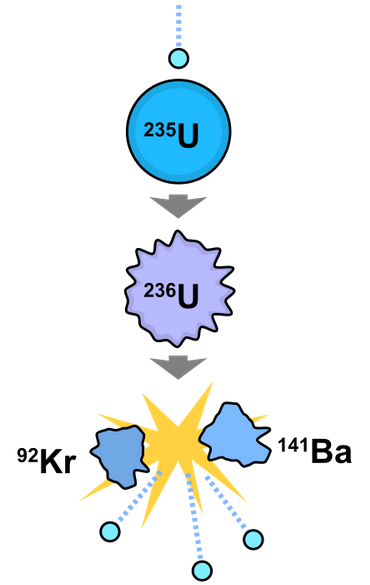 |
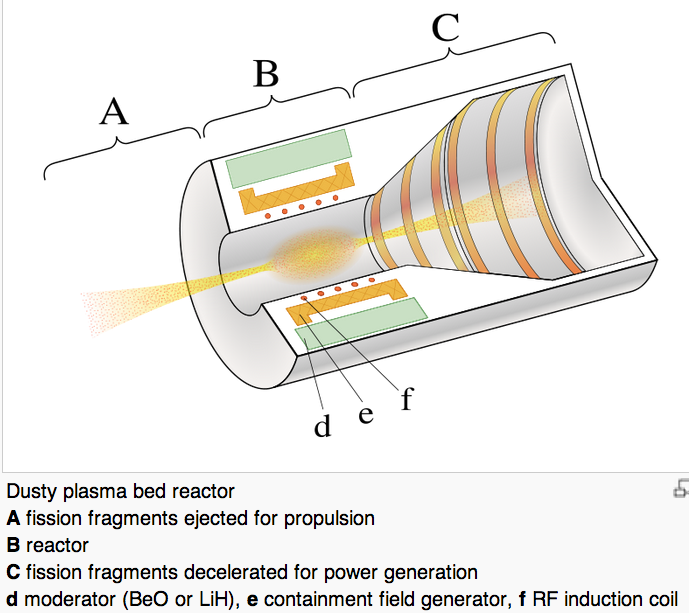 |
|---|---|
When uranium fissions it produces 2 high-speed fragments, which can be herded with magnetic fields to produce thrust.
The characteristic speed of the fragments is 12000 km/s = .039 C. See the appendix for an expanded discussion.
The fuel shold have a critical mass that is as small as possible and the half life should be at least 20 years. The best candidate is Californium-251.
Critical Diameter Halflife
mass (cm) (Myears)
(kg)
Californium-252 2.73 6.9 .0000026
Californium-251 5 8.5 .000290
Californium-249 6 9 .000351
Neptunium-236 7 8.7 .154
Curium-247 7.0 9.9 15.6
Curium-243 8 10.5 .000029
Plutonium-238 9.5 9.7 .000088
Plutonium-239 10 9.9 .024
Curium-245 10 11.5 .0085
Americium-242 11 12 .000141
Plutonium-241 12 10.5 .000014
Uranium-233 15 11 .159
Uranium-235 52 17 704
Neptunium-237 60 18 2.14
Plutonium-240 40 15 .0066
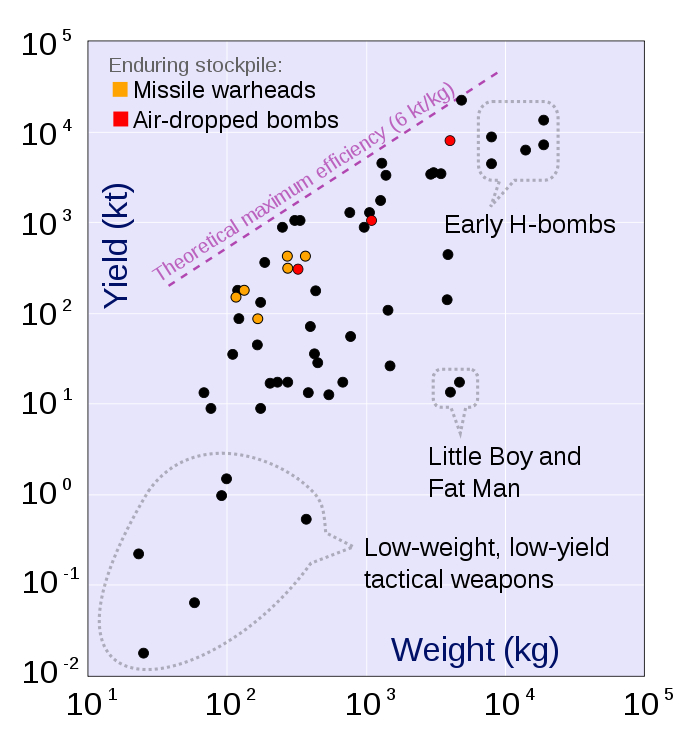 |
|---|
If we assume that all the energy goes into kinetic energy of exhaust, the exhaust speed is
Kinetic energy = .5 M V2 = .000135 M C2 V = 4900 km/s = .0163 CIf hydrogen bombs are used for propulsion then the spaceship has to be large to absorb the recoil.
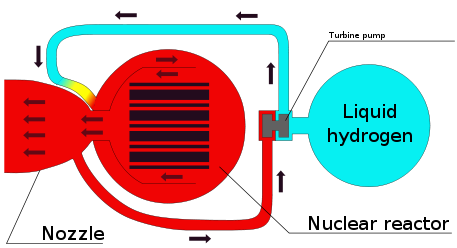 |
|---|
A thermal rocket uses solar or nuclear power to heat a propellant. In space, ice is available in bulk and so either ice or hydrogen can be used for propellant.
Exhaust speed (km/s)
H2 9.0
H2O 1.9
In space, thin reflective material can be used to construct a large low-mass mirror
to focus sunlight. Such a rocket will be able to move large objects such as asteroids.
If an asteroid has its own ice then it's especially easy to move.
The Stratolaunch aircraft is subsonic. A supersonic ramjet such as the SR-71 can move at Mach 5 and can launch a rocket from higher altitude than the Stratolaunch.
Launch method Speed Altitude Air density
(km/s) (km) (kg/m3)
Ground 0 0 1.22 Conventional ground launch
Subsonic aircraft .3 14 .26 Stratolaunch aircraft
SR-71 Blackbird 1.1 26 .038 Fastest existing ramjet
Supersonic ramjet 1.5 30 .03 Maximum speed for a ramjet
Electromagnetic sled 3.0 7 .4
"Speed" refers to the initial speed of the launch vehicle and "Altitude" refers to
the initial altitude of the launch vehicle after it has been accelerated by the
launch system.
Future launch systems will use either a supersonic ramjet or an electromagnetic sled.
If we assume that the kinetic energy of an orbiting object comes from electricity then
Orbital speed = 7.8 km/s Energy of a 1 kg object at orbital speed = 30.4 MJoules Cost of electricity = 36.0 MJoules/$ Cost of a 1 kg object at orbital speed = .84 $
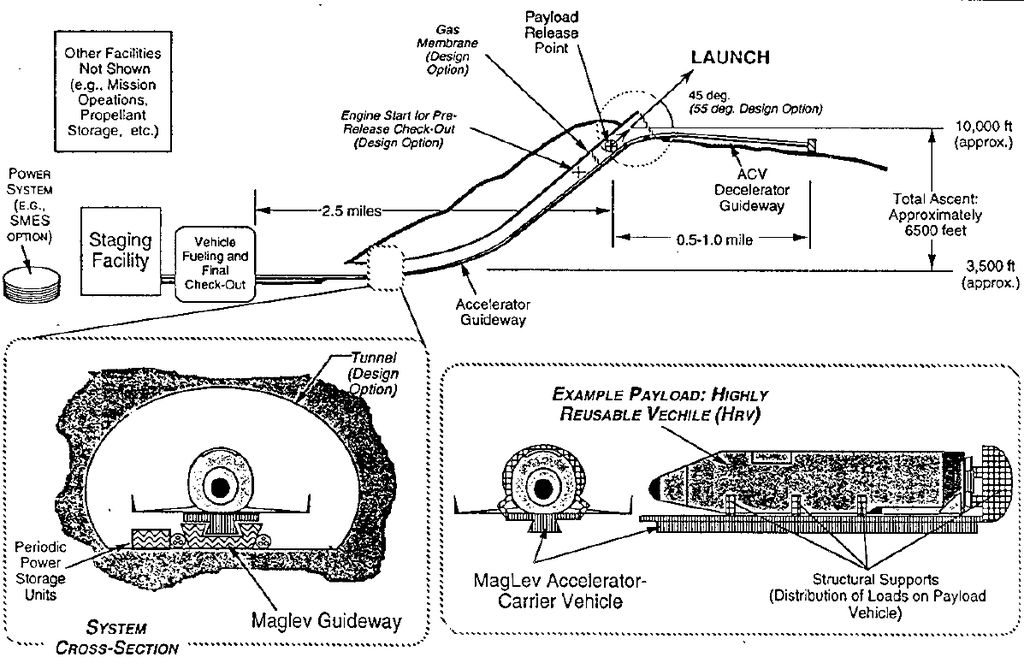 |
|---|
The Holloman Air Force Base does hypersonic research using a sled that can reach a speed of 2.88 km/s.
A launch sled can convert electrial power to sled kinetic energy with an efficiency of 90%.
Example values:
Sled acceleration = A = 50 m/s2 (5 g's. Maximum acceleration for humans) Sled final velocity = V = 3.0 km/s Length of the track = X = 90 km Time spent on track = T = 60 seconds V2 = 2 A X X = .5 A T2If we launch inanimate equipment at an acceleration of 500 m/s2 then the track length is 9 km.
If a sled is moving at 3 km/s then a centripetal acceleration of 5 g corresponds to a radius of curvature of 180 km. The last half of the track has to be straight.
The sled only needs to reach an altitude of ~ 40 km. The rocket can do the rest. If it is launched from Everest then it needs to gain an altitude of ~ 30 km. The vertical velocity required to gain 30 km of altitude is .78 km/s. If the horizontal velocity is 3.0 km/s then the launch slope is .25.
A sled can use a heavy heat shield, which isn't possible with a rocket.
A sled launch track can use a mountain for altitude and launch angle. Possible mountains include:
Peak Height Earth Airmass Mountain range
(m) rotation (tons)
(km/s)
Equator 0 .465 10.1 Sea level
Huascaran 6768 .458 4.1 Huascaran
Yerupaja 6634 .457 4.2 Huascaran
Everest 8848 .41 3.1 Himalayas, Everest
Kangchenjunga 8586 .41 3.3 Himalayas, Everest
Aconcagua 6962 .391 4.0 Aconcagua
K2 8611 .37 3.2 Himalayas, Karakoram
Huascaran is the tallest peak that is close to the equator.
"Airmass" is the mass of air per meter2 above the given height.
The rocket has to have a mass of at least 100 tons for the airmass to not matter.
 |
|---|
As a rocket burns through fuel it gets lighter. The "Tsoilkovsky rocket equation" relates the final rocket speed to the exhaust speed.
T = Time
M(T)= Mass of rocket as a function of time
Mi = Initial mass of rocket
Mf = Final mass of rocket after burning its fuel
Ve = Rocket exhaust speed
V(T)= Rocket speed as a function of time. V(0)=0.
Vf = Final rocket speed after burning its fuel
F = Force generated by the rocket
= - Ve dM/dT
dV/dT = F/M = -(Ve/M) * dM/dT
V(T) = V ln(Mi/M)
Vf = V ln(Mi/Mf) Tsoilkovsky rocket equation
The Oberth maneuver uses a planet's gravity to magnify a rocket impulse.
Suppose a spacecraft is on a highly elliptical orbit, with a perigee slightly larger than the Earth's radius and an apogee vastly larger than the Earth's radius.
Gravity constant = G = 6.67e-11 Newton meters2/kg2 Mass of Earth = M = 5.97e24 kg Earth radius = R = 6371 km/s Perigee radius = R1 Slightly larger than R Apogee radius = R2 R1 << R2 Escape velocity = Vesc= 11.2 km/s Rocket speed at perigee = V1 = Vesc Rocket speed at apogee = 0 Circular orbit speed at perigee = Vcirc= 7.2 km/s = G M / R1 Circular orbit speed at apogee = 0 Rocket speed change at perigee = Vroc = 16.6 km/s Calculated below Final exit speed from planet = Vexit= 25.4 km/s Final speed after far from the planetAt apogee the energy is
E = Kinetic energy + Gravitational energy = 0 + 0At perigee the energy is
E = Kinetic energy + Gravitational energy
= .5 m V12 - G M m / R1
V12 = 2 G M / R1
= 2 Vcirc2
= Vesc2
V1 is equal to the "Escape speed", the speed required to escape the planet.
The escape speed is independent of the direction of the velocity.
The escape velocity can also be obtained from the gravitational potential energy.
.5 m Vesc2 = G M m / R1 → Vesc2 = 2 G M / R1IF the rocket fires at perigee and increases its speed by Vroc, the energy becomes
E = .5 m (V1 + Vroc)2 - G M m / R1 = .5 m (Vesc + Vroc)2 - .5 m Vesc2 = .5 m (Vroc2 + 2 Vroc Vesc)The rocket is now on a hyperbolic orbit and will escape the Earth, As it recedes from the Earth it will approaches a constant velocity Vexit. When far from the Earth, the energy is
E = .5 m (Vroc2 + 2 Vroc Vesc) = .5 m Vexit2 Vexit= (Vroc2 + 2 Vroc Vesc)1/2 > VrocIf the spacecraft starts in an elliptical orbit and changes its speed by Vroc at perigee, it departs the Earth at speed Vexit, which is larger than Vroc. This is the "Oberth effect".
If a rocket changes its velocity by 5 km/s at perigee, it departs the Earth with a velocity of
Vexit= (52 + 2 * 5 * 11.2)1/2
= 11.7 km/s
This gets you to Mars in about 4 months.
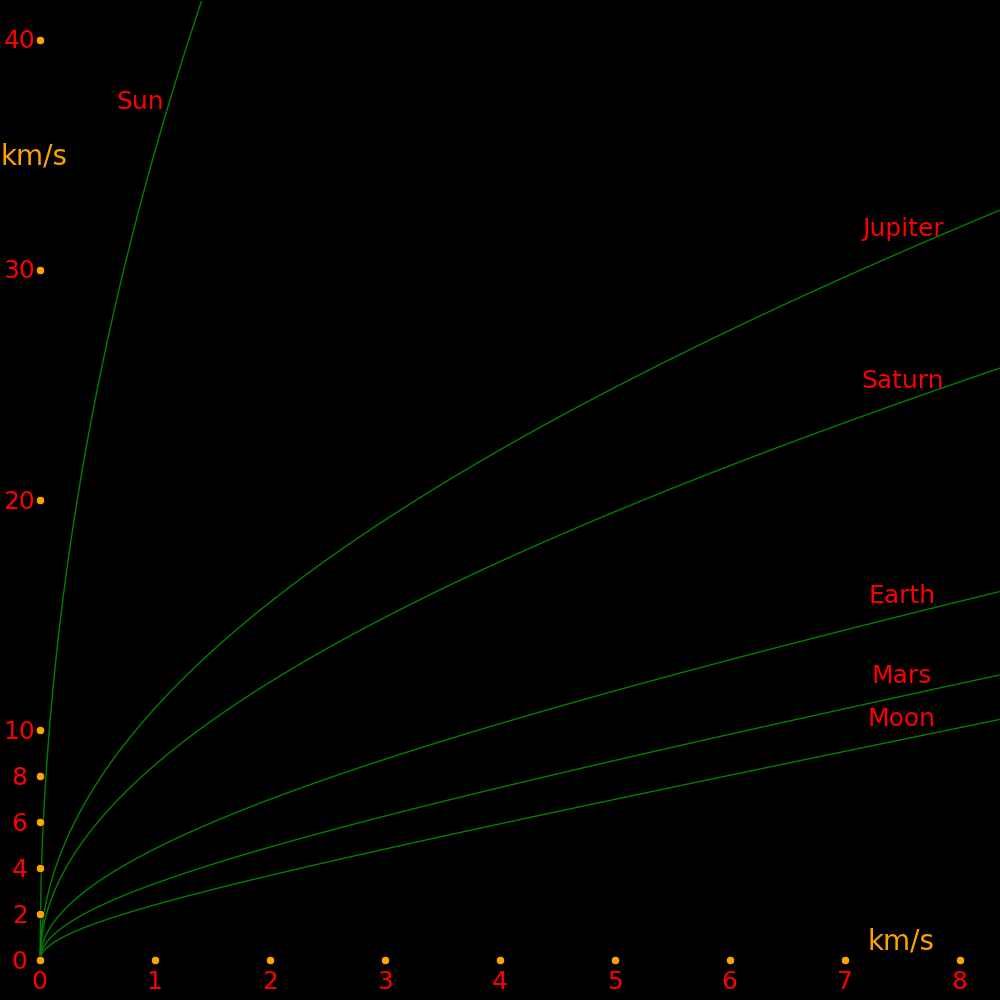 |
|---|
X axis: Change in velocity at perigee (Vroc) Y axis: Departure velocity from the planet. Vexit = (Vroc2 + 2 Vroc Vesc)Each curve corresponds to a different planet.
Escape velocity (km/s)
Moon 2.38
Mars 5.03
Earth 11.2
Saturn 35.5
Jupiter 59.5
Sun 618
The Oberth maneuver requires a rocket with a large thrust-to-mass ratio. The Oberth effect is most useful when the rocket fires at Perigee, meaning the rocket has only a limited time to burn through its fuel. This restricts the rocket types that can be used for an Oberth maneuver. Chemical rockets deliver the most power, which makes them the rocket of choice for Oberth maneuvers. Nuclear rockets have a heating challenge. Ion drives and mirror-based rockets are low-thrust and can't be used for the Oberth maneuver. The rocket engine with the largest force/mass is the Vulcain-2. For this rocket,
Planet radius = R = 6371 km for the Earth
Escape velocity = Ves= 11.2 km/s for the Earth
Oberth time = T = 9.5 minutes for the Earth = R / Ve
= Time that the rocket is near perigee
Rocket exhaust speed = Vex= 4.2 km/s
Rocket force = F = 1359 kiloNewtons
Rocket engine mass = m = 1800 kg
Rocket force/mass = Z = 755 Newtons/kg = F / m
Fuel mass burnt = M = T Z m / Vex = 102 m Fuel mass burnt during one Oberth time
Oberth velocity = Vob= 16.6 km/s = 3.9 Vex = [ln(M/m) - ln(2)] Vex = ln(.5 T Z / Vex) Vex
= [ln(T) - 2.4] Vex
Momentum conservation: M Vex = F T
During one Oberth time, a Vulcain-2 rocket burns 102 times its mass in fuel. The Oberth
time for the Earth is long enough so that a chemical rocket can comfortably burn through all its
fuel.
To calculate the Oberth velocity, we use the Tsoilkovsky rocket equation and assume that the final mass of the spaceship is twice the mass of the rocket engine.
Escape Radius Oberth Oberth Exit
(km/s) time (s) velocity velocity
(km/s) (km/s)
Mercury 4.3 .38 563 16.5 20.4
Venus 10.5 .95 576 16.6 25.0
Earth 11.2 1.00 569 16.6 25.4
Moon 2.38 .27 723 17.6 19.8
Mars 5.03 .53 671 17.3 21.7
Jupiter 59.5 10.9 1167 19.6 52.1
Saturn 35.5 9.0 1615 20.9 43.9
Uranus 21.3 3.97 1187 19.7 35.0
Neptune 23.5 3.86 1046 19.1 35.6
Pluto 1.23 .184 953 18.7 19.9
Sun 618 109.2 1126 19.4 156.2
"Exit velocity" is the maximum exit velocity from the planet using the Oberth maneuver.
It is also equal to the maximum "capture velocity" for using the Oberth maneuver to be captured
by a planet.
Mylar density = 1.39 g/cm3 Aluminum density = 2.70 g/cm3 Mylar thickness = .025 mm Aluminum thickness = .010 mm Area density = 62 tons/km2 = .062 kg/m2
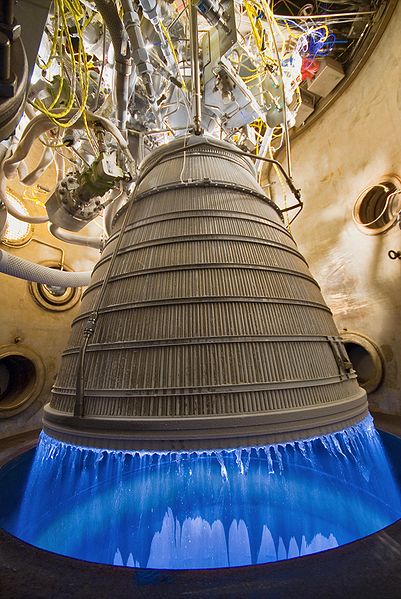 |
|---|
Sea level Vacuum Thrust
Fuel Exhaust Exhaust Mass Thrust /mass
km/s km/s kg kN N/kg
Waxwing Solid 2.72 87 29.4 345
Atlas V Solid 2.70 1270 40.8 tons with fuel
P230 Solid 2.80 6472 268 tons with fuel. Ariane rocket
Shuttle booster Solid 2.42 2.68 12500 21200 590 tons with fuel
Merlin 1D Kerosine 2.76 3.05 630 801 1300 Falcon rocket. Diameter 1.676 m
Merlin 2 Kerosine 3.16 8540 In development by SpaceX. Falcon Heavy
Raptor Methane 3.7 8200 In development by SpaceX
Snecma HM7B HOX 4.3 165 64.8 400 Ariane rocket
RL-10A HOX 4.42 167 99.1 606 Atlas V. Diameter = 2.13 meters
RL10B-2 HOX 4.547 277 110 406 Atlas V and Delta IV rockets
Mitsubishi LE-5B HOX 4.38 285 137.2 490
Mitsubishi LE-7A HOX 4.31 1800 1098 620
Vulcain 2 HOX 4.20 1800 1359 755 Ariane rocket. Diameter = 1.76 m
Shuttle engine HOX 3.56 4.44 3500 1700 496
RS-68 HOX 4.02 6600 3370 520 Most powerful HOX rocket
HOX = liquid hydrogan + liquid oxygen
Kerosine = kerosine + liquid oxygen
Solid = aluminum + ammonium perchlorate (N H4 Cl O4)
Methane = methane + liquid oxygen
 |
.jpg) |
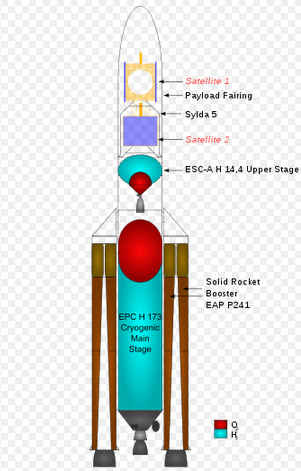 |
|---|---|---|
 |
 |
 |
|---|---|---|
Stage 1 Stage 2 Stage 3
Mass Thrust Exh Mass Thrust Exh Mass Thrust Exh Payload Payload
kkg kN km/s kkg kN km/s kkg kN km/s kkg $/kg
Space Shuttle 1710 25000 ~2.6 530 5100 4.44 ? 5100 4.44 93.
SpaceX Falcon 9 506 6672 ~2.9 52 801 3.35 - - - 13.15 4109
SpaceX Falcon Heavy 1400 17000 ~2.9 ~480 5600 3.05 ? 445 3.35 53. 2200
Saturn V 2800 34000 2.58 710 4400 4.13 230 1000 4.13 118.00 9915
Ariane 777 12940 2.80 ? 1340 4.22 ? 64.7 4.37 16. 10500
Pegasus 23.1 .443
Stratolaunch ? 1500 n/a 230 ? ? ? ? ? 6.12
Earth rotation at equator = 463 m/s.
Earth escape speed = 11.186
Earth orbit speed at 160 km = 7.58 km/s
Falcon 9 stage 2 empty mass = 3.1 tons
Falcon 9 Sea level thrust = 5885 kN
Space shuttle: The space shuttle orbiter has a mass of 68.6 and a payload of 24.4 tons.
Saturn V: Largest payload ever achieved. Launched the moon missions.
Pegasus: Air launch
Stratolaunch: A 6-engine airplane launches the "Pegasus II" rocket.
The Stratolaunch airplane is moving at ~ .3 km/s when it launches the
rocket, and the launch can occur at the equator where the Earth's rotation
speed is .46 km/s. This gives the rocket a total initial speed of .76 km/s.
 |
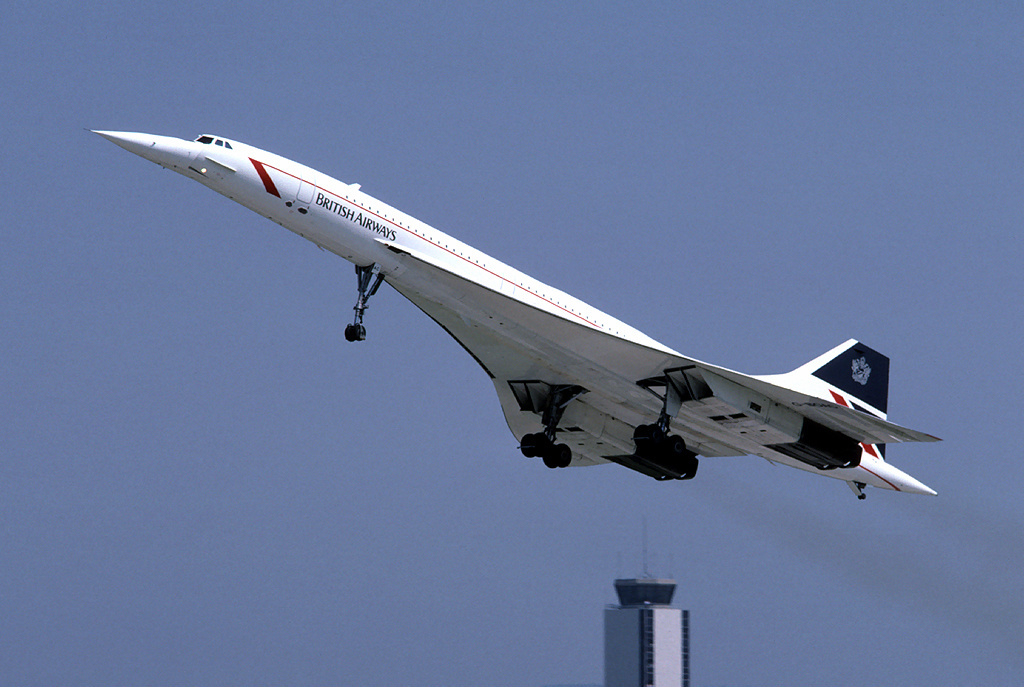 |
|---|---|
Engine Engine Empty Max Cargo
Speed Ceiling thrust mass mass takeoff mass
(Mach) km (tons) (tons) (tons) (tons) (tons)
Blackbird SR-71 3.3 25.9 2 x 14.8 2 x 2.7 30.6 78 Spy
F-15 Eagle 2.5 20.0 2 x 11.3 2 x 1.70 12.7 30.8 Fighter
F-22 Raptor 2.25 19.8 2 x 15.9 2 x 1.77 19.7 38 Stealth Fighter
Concorde 2.02 18.3 4 x 17.2 4 x 3.18 78.7 187 128 passengers
Airbus A380 .96 13.1 4 x 38.2 4 x 6.27 276.8 650 853 passengers
Boeing C-5 Galaxy .8 4 x 19.4 4 x 3.63 172.4 381 122.5 Cargo
Boeing 747-8F .86 13.0 4 x 30.2 4 x 5.6 448 134.2 Cargo
Antonov 224 .75 4 x 23.4 4 x 4.1 175 405 150 Cargo
Antonov 225 .7 6 x 23.4 6 x 4.1 285 640 250 Cargo
Stratolaunch 6 x 25.5 540 230 Orbital launch platform
The Stratolaunch (in development) is designed to launch rockets into space.
Drag force = .5 * AirDensity * CrossSection * Velocity^2 M = Rocket Mass / 400 tons A = Acceleration / 10 m/s^2 Acceleration in units of g's D = Air Density / 1 kg/m^3 Density = 1.28 kg/m^3 at sea level C = Cross section / 10 m^2 The Falcon 9 rocket has a cross section of 10 m^2 V = Velocity / 300 m/s Velocity in units of "Mach"In these units the drag equation is
10 A M ~ D C V^2 For a falcon 9 rocket, M=1 and C=1. If the rocket is at sea level, D ~ 1.If the drag acceleration is 1g, then V ~ 3 (Mach 3). This sets the speed limit for rockets in the lower atmosphere.
Fuel Exhaust Density Boil kNewtons kNewtons kNewtons Diameter Mass Rocket engine used
(km/s) (g/cm^3) (K) /meter^2 /ton (meters) (kg) for data
Liquid hydrogen 4.2 .07 20.3 559 755 1359 1.76 1800 Vulcain-2
Liquid methane 3.7 .42 111.7 493 ? 8200 4.6 ? Raptor
Kerosine 3.3 .80 410 361 1270 801 1.676 630 Merlin-1D
Solid fuel 2.7 1.2 - 673 ? 1270 1.55 ? Atlas V booster
Kerosine ramjet .80 410 9.0 5.5 14.8 1.45 2.7 SR-71 Blackbird
Hydrogen, methane, and kerosine are all reacted with liquid oxygen that is
carried by the rocket. Solid fuel contains its own oxidizer.
For the kerosine ramjet, kerosine is reacted with oxygen from the air.
"kNewtons/meter^2" is the thrust/area of the rocket.
"kNewtons/kg" is the thrust-to-mass ratio of the rocket engine.
The density of liquid oxygen is 1.14 g/cm^3 and the boiling point is 90.2 Kelvin.
The energy required to split H2O into H2 and O2 is 1.317e7 Joules/kg, and the maximum efficiency of this process is 0.83.
Sp = Solar cell power/kg = 300 Watts/kg Sc = Solar cell $/kg = 3000 $/kg T = Time required for a 1 kg solar cell to produce 1 kg of HOX fuel = Energy required to produce 1 kg of HOX fuel / Power produced by a 1 kg solar cell = 1.317e7 / .83 / 300 = 52900 seconds = .61 days
We can calculate the maximum speed of HOX rocket exhaust from the energy required to split H2O.
V = Maximum speed of rocket exhaust for a HOX rocket 1.317e7 Joules/kg = .5 V^2 V = 5.132 km/sIn practice, the best HOX rockets have an exhaust speed of 4.4 km/s.
Fission of Uranium-235:
Mean energy produced per fission 202.5 MeV
Mean kinetic energy of the fission fragments (daughter nuclei) 169 MeV
Mean kinetic energy of the neutrons produced 4.8 MeV
Mean energy produced by radioactivity of the daughter nuclei 28.7 MeV
Rest energy of the original U-235 nucleus 218900 MeV
1 MeV = 10^6 eV = 1.6*10^-13 Joules
1 Atomic mass unit = 1.6605*10^-27 kg = 931.494 MeV/C^2
Mass of Uranium-235 = 235.04 atomic mass units
Only the kinetic energy of the fission fragments is harnessable by a rocket.
C = Speed of light
Mt= Mass of original nucleus
E = Kinetic energy of the fission fragments
F = Fraction of the mass of the original nucleus that is
converted into kinetic energy.
= E / (Mt C^2)
= 169 MeV / (235.04 * 931.49)
= .000772
Vt= Characteristic speed of the fission fragments
.5 Mt Vt^2 ~ F Mt C^2
Vt = .0393 C
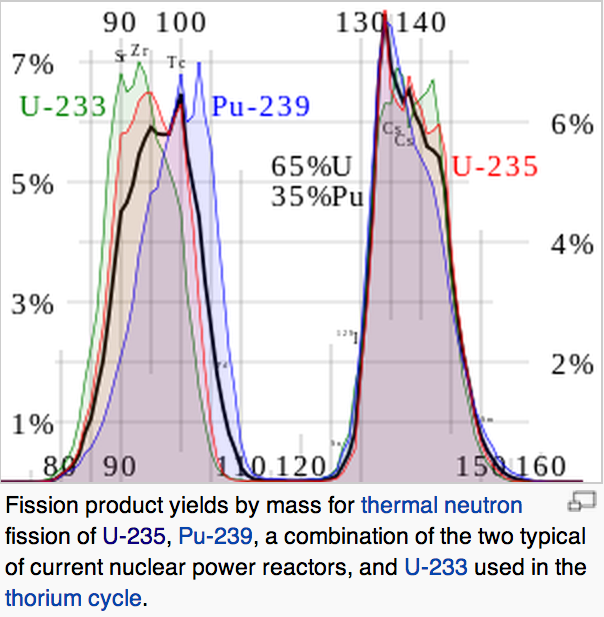 |
|---|
Fission tends to produce two fragments, one heavier than the other. The distribution is similar for all fissionable nuclei.
E = Total kinetic energy in fission fragments ~ 169 MeV
F = Fraction of the mass of the original nucleus that is converted into kinetic energy.
= .000772
M = Mass of heavy fragment ~ .40 * Mass of original nucleus
m = Mass of light fragment ~ .58 * Mass of original nucleus
V = Velocity of heavy fragment
v = Velocity of light fragment
Conservation of momentum: M V = m v
Conservation of energy: E = .5 M V^2 + .5 m v^2
M^2 V^2 (M + m) = 2 E M m
V^2 = 2 F C^2 m / M
v^2 = 2 F C^2 M / m
V = .0326 C
v = .0473 C
Critical mass Half life
Americium-242 .5 141 years Costs ~ 10^6 $/kg
Californium-251 .9 898 years
Curium-245 1.1 8500 years
Plutonium-239 5.6 241000 years
Uranium-235 11.0 704 million years
For a fission fragment rocket, the lower the critical mass the better.
All of the above isotopes produce similar energy when fissioned.
Hydrogen bombs use the following reactions.
Neutron + Lithium6 --> Tritium + Helium4 + 4.874 MeV Deuterium + Tritium --> Helium4 + Neutron + 17.56 MeVLeaving out the neutron catalyst, this is
Deuterium + Lithium6 --> Helium4 + Helium4 + 22.43 MeV
Nucleons = 8
Energy / Nucleon = 22.434/8
= 2.80 MeV/Nucleon
f = Fraction of mass converted to energy
= (2.80 MeV/Nucleon) / (939 MeV/Nucleon)
= .00298
The theoretical limit for the efficiency of a hydrogen bomb is
f = .00027In practice, f is half this.
A thermal rocket uses a power source to heat the propellant. The power can come from either a nuclear reactor or from sunlight focused by mirrors.
Propellant Exhaust speed
(km/s)
H2 9
H2O 1.9
Energy
Hydrogen + Oxygen 1.4e10 Joules/ton
Uranium-235 8.0e16 Joules/ton
Solar energy 1.4e15 Joules. 1 km^2 collector operating for 10^6 seconds at 1 A.U.
A mirror-based thermal rocket offers a means for using H2O as propellant. Such a
rocket can potentially move large asteroids.
The solar energy collected by a 1km mirror at 1 A.U. over a time of 10^6 seconds (2 weeks) is
Energy ~ 1400 Watts/m^2 * 10^6 m^3 * 10^6 seconds ~ 1.4e15The mass of the mirror is
Surface area Thickness Density
Mirror mass ~ 8*10^5 kg -------------- ----------- ----------
1 km^2 10^-4 m 8 g/cm^3
A solar thermal rocket capable of delivering ~ 10^16 Watts can be built
from a ~ 10 meter metallic asteroid.
If a thermal rocket can operate at a temperature high enough to dissociate H2 into elemental hydrogen then larger exhaust speeds are possible.
Suppose we use mylar film for a space mirror.
Mirror density = 1390 kg/m^3 Mirror thickness = .1 mm Mirror mass/area = .139 kg/m^2 Solar flux = 1362 Watts/m^2 H2O exhaust speed = 1.9 km/s H2O mass/time/area = .00075 kg/s/m^2 Mass of propellant per time per area Mirror acceleration = 10.3 m/sThe acceleration of a mirror rocket is limited by the strength of the mirror.
 |
|---|